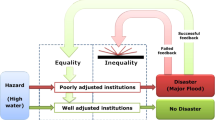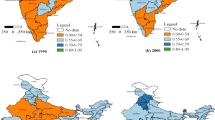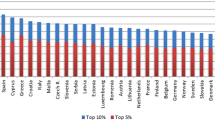Abstract
Today, Latin American countries are characterized by relatively high levels of economic inequality. This circumstance has often been considered a long-run consequence of the Spanish conquest and of the highly extractive institutions imposed by the colonizers. Here we show that, in the case of the Aztec Empire, high inequality predates the Spanish conquest, also known as the Spanish–Aztec War. We reach this conclusion by estimating levels of income inequality and of imperial extraction across the empire. We find that the richest 1% earned 41.8% of the total income, while the income share of the poorest 50% was just 23.3%. We also argue that those provinces that had resisted the Aztec expansion suffered from relatively harsh conditions, including higher taxes, in the context of the imperial system—and were the first to rebel, allying themselves with the Spaniards. Existing literature suggests that after the Spanish conquest, the colonial elites inherited pre-existing extractive institutions and added additional layers of social and economic inequality.
This is a preview of subscription content, access via your institution
Access options
Access Nature and 54 other Nature Portfolio journals
Get Nature+, our best-value online-access subscription
$29.99 / 30 days
cancel any time
Subscribe to this journal
Receive 12 digital issues and online access to articles
$119.00 per year
only $9.92 per issue
Buy this article
- Purchase on Springer Link
- Instant access to full article PDF
Prices may be subject to local taxes which are calculated during checkout


Similar content being viewed by others
Data availability
All data and replication files used in the analyses have been deposited in the OpenICPSR data repository (https://www.openicpsr.org/openicpsr/project/186521/version/V2/view) for purposes of reproducing or extending the analysis.
References
Prados de la Escosura, L. in The New Comparative Economic History (eds Hatton, T. J. et al.) Ch. 12 (MIT Press, 2007).
Milanovic, B. Global Inequality: A New Approach for the Age of Globalization (Harvard Univ. Press, 2016).
Bértola, L., Castelnuovo, C., Rodrìguez, J. & Willebald, H. Income distribution in the Latin American southern cone during the first globalization and boom and beyond. Int. J. Comp. Sociol. 50, 452–485 (2009).
Acemoglu, D., Johnson, S. & Robinson, J. A. Reversal of fortune: geography and institutions in the making of the modern world income distribution. Q. J. Econ. 117, 1231–1294 (2002).
Engerman, S. L. & Sokoloff, K. L. in How Latin America Fell Behind: Essays on the Economic History of Brazil and Mexico, 1800–1914 (ed. Haber, S.) Ch. 10 (Stanford Univ. Press, 1997).
Acemoglu, D., Johnson, S. & Robinson, J. A. The colonial origins of comparative development: an empirical investigation. Am. Econ. Rev. 91, 1369–1401 (2001).
Smith, M. E. & Hicks, F. in The Oxford Handbook of the Aztecs (eds Nichols, D. L. & Rodríguez-Alegría, E.) Ch. 29 (Oxford Univ. Press, 2017).
Smith, M. E. & Montiel, L. The archaeological study of empires and imperialism in pre-Hispanic Central Mexico. J. Anthr. Arch. 20, 245–284 (2001).
Gutiérrez, G. in Merchants, Markets, and Exchange in the Pre-Columbian World (eds Hirth, K. G. & Pillsbury, J.) Ch. 6 (Dumbarton Oaks, 2013).
Olson, J. M. & Smith, M. E. Material expressions of wealth and social class at Aztec-period sites in Morelos, Mexico. Anc. Mesoam. 27, 133–147 (2016).
Carrasco, P. in Historia General de México (ed. Cosío-Villegas, D.) Ch. 4 (Colegio de México, 2000).
Hassig, R. Mexico and the Spanish Conquest (Univ. Oklahoma Press, 2006).
Zavala, S. La encomienda indiana. Trim. Econ. 2, 423–451 (1935).
Carrasco, P. The Tenochca Empire of Ancient Mexico: The Triple Alliance of Tenochtitlan, Tetzcoco, and Tlacopan (Univ. of Oklahoma Press, 1999).
Berdán, F. F. in The Encyclopedia of Empire (eds MacKenzie, J. M. et al.) 1–8 (Wiley-Blackwell, 2015).
Smith, M. E. in Fiscal Regimes and the Political Economy of Premodern States (eds Monson, A. & Scheidel, W.) Ch. 3 (Cambridge Univ. Press, 2015).
Smith, M. E. The Aztecs paid taxes, not tribute. Mexicon 36, 19–22 (2014).
Rojas, J. L. La moneda indígena en México. Rev. Esp. Antrop. Am. 17, 75–88 (1987).
Berdan, F. F., Hirth, K. G., Nichols, D. L. & Smith, M. E. in Rethinking the Aztec Economy (eds Nichols, D. L. et al.) Introduction (Univ. of Arizona Press, 2017).
Denevan, W. M. The Native Population of the Americas in 1492 (Univ. Wisconsin Press, 1992).
Smith, M. E. in Empires: Perspectives from Archaeology and History (eds Alcock, S. E. et al.) Ch. 5 (Cambridge Univ. Press, 2001).
Smith, M. E. & Berdan, F. F. in Aztec Imperial Strategies (eds Berdan, F. F. et al.) Ch. 1 (Dumbarton Oaks, 1996).
Brumfiel, E. M. Aztec state making: ecology, structure, and the origin of the state. Am. Anthr. 85, 261–284 (1983).
Brumfiel, E. M. & Fox, J. W. Factional Competition and Political Development in the New World Paperback (Cambridge Univ. Press, 2003).
Smith, M. E. Aztec City-State Capitals (Univ. Press Florida, 2008).
Berdan, F. Late Postclassic Mesoamerican trade networks and imperial expansion. J. Glob. Stud. 8, 14–29 (2017).
Smith, M. E. in Empires: Perspectives from Archaeology and History (eds Alcock, S. E. et al.) Ch. 5 (Cambridge Univ. Press, 2011).
Smith, M. S. The role of social stratification in the Aztec empire: a view from the provinces. Am. Anthr. 88, 70–91 (1986).
Boserup, E. Population and Technological Change: A Study of Long-Term Trends (Univ. Chicago Press, 1981).
Maloney, W. F. & Valencia Caicedo, F. The persistence of subnational fortune. Econ. J. 126, 2363–2401 (2016).
Parsons, J. R. Prehistoric Settlement Patterns in Texcoco Region, Mexico (Museum of Anthropology & Univ. Michigan, 1971).
Brumfiel, E. M. in The Early Mesoamerican Village (ed. Flannery, K. V.) Ch. 8 (Academic Press, 1976)
Milanovic, B. An estimate of average income and inequality in Byzantium around year 1000. Rev. Inc. Wealth 52, 449–470 (2006).
Milanovic, B. Income level and income inequality in the Euro-Mediterranean region, c. 14–700. Rev. Inc. Wealth 65, 1–20 (2019).
Broadberry, S., Custodis, J. & Gupta, B. India and the great divergence: an Anglo-Indian comparison of GDP per capita, 1600–1871. Exp. Econ. Hist. 55, 58–75 (2015).
Fouquet, R. & Broadberry, S. Seven centuries of European economic growth and decline. J. Econ. Perspect. 29, 227–244 (2015).
Prados de la Escosura, L. Growth Recurring in Preindustrial Spain: Half a Millennium Perspective Working Paper No. 177 (EHES, 2020).
Kohler, T. A. et al. Greater post-Neolithic wealth disparities in Eurasia than in North America and Mesoamerica. Nature 551, 619–622 (2017).
Bogaard, A., Fochesato, M. & Bowles, S. The farming–inequality nexus: new methods and evidence from western Eurasia. Antiquity 93, 1–15 (2019).
Smith, M. E. in Archaeological Views from the Countryside: Village Communities in Early Complex Societies (eds Schwarts, G. & Falconer, S.) Ch. 10 (Smithsonian Institution Press, 1994).
Scheidel, W. The Great Leveler: Violence and the History of Inequality from the Stone Age to the Twenty-First Century (Princeton Univ. Press, 2017).
Milanovic, B., Lindert, P. H. & Williamson, J. G. Pre‐industrial inequality. Econ. J. 121, 255–272 (2011).
Van Zanden, J. L. Tracing the beginning of the Kuznets curve: Western Europe during the early modern period. Econ. Hist. Rev. 48, 643–664 (1995).
Alfani, G. Economic inequality in preindustrial times: Europe and beyond. J. Econ. Lit. 59, 3–44 (2021).
Restall, M. Los Siete Mitos de la Conquista Española (Ediciones Paidós, 2004)
Livi-Bacci, M. The depopulation of Hispanic America after the conquest. Pop. Dev. Rev. 32, 199–232 (2006).
Livi-Bacci, M. The demise of the American Indios. Pop. Dev. Rev. 37, 161–165 (2011).
Arroyo Abad, L. & van Zanden, J. L. Growth under extractive institutions? Latin American per capita GDP in colonial times. J. Econ. Hist. 76, 1182–1215 (2016).
Dell, M. The persistent effects of Peru’s mining mita. Econometrica 78, 1863–1903 (2010).
Gibson, C. Los Aztecas Bajo el Dominio Español, 1519–1810 (Siglo XXI, 1978).
Sanders, W. T. in The Native Population of the Americas, 1492 (ed. Denevan, W. M.) Ch. 4 (Univ. Wisconsin Press, 1992).
Batalla Rosado, J. J. The scribes who painted the Matrícula de Tributos and the Codex Mendoza. Anc. Mesoam. 18, 31–51 (2007).
Ashraf, Q. & Galor, O. Dynamics and stagnation in the Malthusian epoch. Am. Econ. Rev. 101, 2003–2041 (2011).
Williamson, J. G. Five centuries of Latin American income inequality. Rev. Hist. Econ. 28, 227–252 (2010).
Barlow, R. H. The Extent of the Empire of the Culhua Mexica (Univ. California Press, 1949).
Carrasco, P. Los mayeques. Hist. Mex. 39, 123–166 (1989).
Rojas, J. L. in The Oxford Handbook of the Aztecs (eds Nichols, D. L. & Rodríguez-Alegría, E.) Ch. 15 (Oxford Univ. Press, 2017).
Rojas, J. L. Tenochtitlan, Capital of the Aztec Empire (Univ. Press of Florida, 2012).
Smith, M. E. in The Oxford Handbook of the Aztecs (eds Nichols, D. L. & Rodríguez-Alegría, E.) Ch. 14 (Oxford Univ. Press, 2017).
Gutiérrez, G. in Merchants, Markets, and Exchange in the Pre-Columbian World (eds Hirth, K. G. & Pillsbury, J.) Ch. 6 (Dumbarton Oaks, 2013).
Rojas, J. L. & Batalla, J. J. Los números ocultos del códice Mendoza y la matrícula de tributos. Rev. Esp. Antrop. Am. 38, 199–206 (2008).
Berdan, F. La organización del tributo en el imperio azteca. Est. Cult. Náhuatl 12, 185–196 (1976).
Gibson, C. in Handbook of Middle American Indians (eds Ekholm, G. F. & Bernal, I.) Ch. 15 (Univ. Texas Press, 1971).
Carrasco, P. Estructura Político-Territorial del Imperio Tenochca: La Triple Alianza de Tenochtitlan, Tetzcoco y Tlacopan (Fondo de Cultura Económica, 1996).
Borah, W. W. & Cook, S. F. Price Trends of Some Basic Commodities in Central Mexico, 1531–1570 (Univ. California Press, 1958).
Rojas, J. L. Cuantificaciones referentes a la ciudad de Tenochtitlan en 1519. Hist. Mex. 36, 213–250 (1986).
Broda, J. in Economía Política e Ideología en el México Prehispánico (eds Carrasco, P. & Broda, J.) Ch. 4 (Centro de Investigaciones Superiores del Instituto Nacional de Antropología e Historia, 1978).
World Income Inequality Database version 31 May 2021 (United Nations University World Institute for Development Economics Research, 2021).
Acknowledgements
We thank F. Billari and L. Prados de la Escosura for their advice. The research leading to this Article received funding from the European Research Council under the European Union’s Horizon 2020 Framework Program (ERC grant agreement no. 725687, G.A.), SMITE—Social Mobility and Inequality across Italy and Europe, 1300–1800. The funders had no role in study design, data collection and analysis, decision to publish or preparation of the manuscript.
Author information
Authors and Affiliations
Contributions
G.A. and A.C. contributed equally to the work and were involved in all tasks.
Corresponding author
Ethics declarations
Competing interests
The authors declare no competing interests.
Peer review
Peer review information
Nature Human Behaviour thanks Branko Milanovic and the other, anonymous, reviewer(s) for their contribution to the peer review of this work.
Additional information
Publisher’s note Springer Nature remains neutral with regard to jurisdictional claims in published maps and institutional affiliations.
Supplementary information
Supplementary Information
Supplementary Fig. 1, Tables 1–45, Methods and references.
Rights and permissions
Springer Nature or its licensor (e.g. a society or other partner) holds exclusive rights to this article under a publishing agreement with the author(s) or other rightsholder(s); author self-archiving of the accepted manuscript version of this article is solely governed by the terms of such publishing agreement and applicable law.
About this article
Cite this article
Alfani, G., Carballo, A. Income and inequality in the Aztec Empire on the eve of the Spanish conquest. Nat Hum Behav 7, 1265–1274 (2023). https://doi.org/10.1038/s41562-023-01636-3
Received:
Accepted:
Published:
Issue Date:
DOI: https://doi.org/10.1038/s41562-023-01636-3



